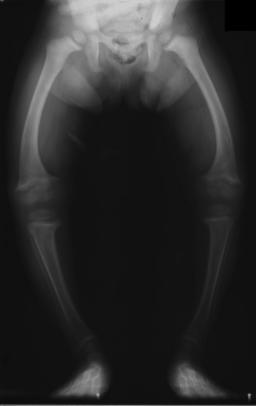Sir,
We read with interest the article in the May 2003 issue by Hosalker et al1 entitled 'Linear sebaceous naevus syndrome and resistant rickets'.
The first patient (case 1 ) is now being followed up at our hospital. The authors mentioned that when he was discharged after follow-up he was walking independently. Unfortunately, he is not doing as well as we had hoped.
He presented to us at 12 years of age having outgrown his Rush nail. He had a right tibia recurvatum deformity with extrusion of the Rush nail from the bone and a leg length discrepancy of 6 cm. Since then, he has undergone revision of the Rush nails in both tibiae and an epiphysiodesis of the upper left tibia. The bone quality of the tibiae has always been poor due to his disease and stress shielding. Despite bone grafting of the right tibia at the time of repeating nailing, the bone quality remains poor. he is now 16-years-old and prefers full-time use of a wheelchair. which is fortuitous because the management of fractures of his tibiae would be exceedingly complex. Needless to say, his compliance with medical treatment has been appalling.
B. GUHAN. Clinical Fellow
R. D. D. DUNCAN. Consultant Orthopaedic Surgeon
Royal Hospital for Sick Children
Glasgow. Scotland.
1. Hosalker HS, Jones DH, Offiah A, Hall C. Linear sebaceous naevus syndrome and resistant rickets. J Bone Joint Surg [Br] 2003: 85-B: 578-83.
Author's reply:
Sir,
We thank Messrs Guhan and Duncan for describing a finding, which is gradually becoming apparent to us. Their patient (our case 1) is deteriorating after initial good progress. The lack of compliance with medical treatment is also noted.
Case 3 in our series is generally doing well and is compliant with treatment because of his gastrostomy. he is also fully weight-bearing on his left lower limb. However, his right lower limb, now straight after nailing of the femur and tibia, has major shortening with growth plate disturbance. This could not be equalised surgically. We are therefore committed to an extension prosthesis with possible surgery to accommodate this.
The long-term outcome of the skeletal problems associated with linear sebaceous naevus syndrome (LSNS) is likely to be less optimistic than originally thought. Only longer term follow-up, continued hopefully with the experiences of others who have treated the condition, will give us more reliable information.
We would be very interested to hear of experiences of the skeletal problems associated with LSNS.
D. H. JONES. FRCS. FRCS Ed (Orth)
Great Ormond Street Hospital for Children
London, UK.
Copyright British Editorial Society of Bone & Joint Surgery Jan 2004
Provided by ProQuest Information and Learning Company. All rights Reserved



